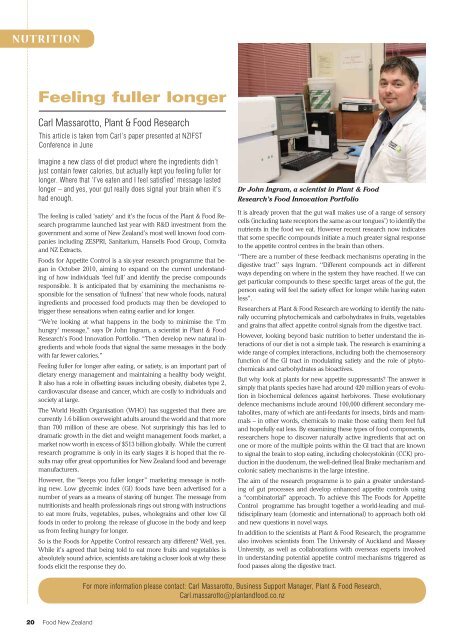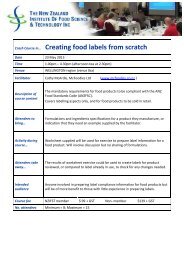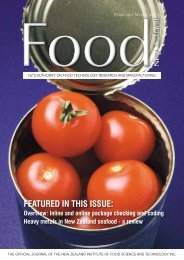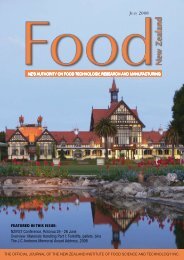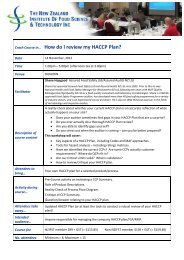featured in this issue - NZIFST - The New Zealand Institute of Food ...
featured in this issue - NZIFST - The New Zealand Institute of Food ...
featured in this issue - NZIFST - The New Zealand Institute of Food ...
Create successful ePaper yourself
Turn your PDF publications into a flip-book with our unique Google optimized e-Paper software.
NUTRITION<br />
Feel<strong>in</strong>g fuller longer<br />
Carl Massarotto, Plant & <strong>Food</strong> Research<br />
This article is taken from Carl’s paper presented at <strong>NZIFST</strong><br />
Conference <strong>in</strong> June<br />
Imag<strong>in</strong>e a new class <strong>of</strong> diet product where the <strong>in</strong>gredients didn’t<br />
just conta<strong>in</strong> fewer calories, but actually kept you feel<strong>in</strong>g fuller for<br />
longer. Where that ‘I’ve eaten and I feel satisfied’ message lasted<br />
longer – and yes, your gut really does signal your bra<strong>in</strong> when it’s<br />
had enough.<br />
<strong>The</strong> feel<strong>in</strong>g is called ‘satiety’ and it’s the focus <strong>of</strong> the Plant & <strong>Food</strong> Research<br />
programme launched last year with R&D <strong>in</strong>vestment from the<br />
government and some <strong>of</strong> <strong>New</strong> <strong>Zealand</strong>’s most well known food companies<br />
<strong>in</strong>clud<strong>in</strong>g ZESPRI, Sanitarium, Hansells <strong>Food</strong> Group, Comvita<br />
and NZ Extracts.<br />
<strong>Food</strong>s for Appetite Control is a six-year research programme that began<br />
<strong>in</strong> October 2010, aim<strong>in</strong>g to expand on the current understand<strong>in</strong>g<br />
<strong>of</strong> how <strong>in</strong>dividuals ‘feel full’ and identify the precise compounds<br />
responsible. It is anticipated that by exam<strong>in</strong><strong>in</strong>g the mechanisms responsible<br />
for the sensation <strong>of</strong> ‘fullness’ that new whole foods, natural<br />
<strong>in</strong>gredients and processed food products may then be developed to<br />
trigger these sensations when eat<strong>in</strong>g earlier and for longer.<br />
“We’re look<strong>in</strong>g at what happens <strong>in</strong> the body to m<strong>in</strong>imise the ‘I’m<br />
hungry’ message,” says Dr John Ingram, a scientist <strong>in</strong> Plant & <strong>Food</strong><br />
Research’s <strong>Food</strong> Innovation Portfolio. “<strong>The</strong>n develop new natural <strong>in</strong>gredients<br />
and whole foods that signal the same messages <strong>in</strong> the body<br />
with far fewer calories.”<br />
Feel<strong>in</strong>g fuller for longer after eat<strong>in</strong>g, or satiety, is an important part <strong>of</strong><br />
dietary energy management and ma<strong>in</strong>ta<strong>in</strong><strong>in</strong>g a healthy body weight.<br />
It also has a role <strong>in</strong> <strong>of</strong>fsett<strong>in</strong>g <strong>issue</strong>s <strong>in</strong>clud<strong>in</strong>g obesity, diabetes type 2,<br />
cardiovascular disease and cancer, which are costly to <strong>in</strong>dividuals and<br />
society at large.<br />
<strong>The</strong> World Health Organisation (WHO) has suggested that there are<br />
currently 1.6 billion overweight adults around the world and that more<br />
than 700 million <strong>of</strong> these are obese. Not surpris<strong>in</strong>gly <strong>this</strong> has led to<br />
dramatic growth <strong>in</strong> the diet and weight management foods market, a<br />
market now worth <strong>in</strong> excess <strong>of</strong> $513 billion globally. While the current<br />
research programme is only <strong>in</strong> its early stages it is hoped that the results<br />
may <strong>of</strong>fer great opportunities for <strong>New</strong> <strong>Zealand</strong> food and beverage<br />
manufacturers.<br />
However, the “keeps you fuller longer” market<strong>in</strong>g message is noth<strong>in</strong>g<br />
new. Low glycemic <strong>in</strong>dex (GI) foods have been advertised for a<br />
number <strong>of</strong> years as a means <strong>of</strong> stav<strong>in</strong>g <strong>of</strong>f hunger. <strong>The</strong> message from<br />
nutritionists and health pr<strong>of</strong>essionals r<strong>in</strong>gs out strong with <strong>in</strong>structions<br />
to eat more fruits, vegetables, pulses, wholegra<strong>in</strong>s and other low GI<br />
foods <strong>in</strong> order to prolong the release <strong>of</strong> glucose <strong>in</strong> the body and keep<br />
us from feel<strong>in</strong>g hungry for longer.<br />
So is the <strong>Food</strong>s for Appetite Control research any different? Well, yes.<br />
While it’s agreed that be<strong>in</strong>g told to eat more fruits and vegetables is<br />
absolutely sound advice, scientists are tak<strong>in</strong>g a closer look at why these<br />
foods elicit the response they do.<br />
Dr John Ingram, a scientist <strong>in</strong> Plant & <strong>Food</strong><br />
Research’s <strong>Food</strong> Innovation Portfolio<br />
It is already proven that the gut wall makes use <strong>of</strong> a range <strong>of</strong> sensory<br />
cells (<strong>in</strong>clud<strong>in</strong>g taste receptors the same as our tongues’) to identify the<br />
nutrients <strong>in</strong> the food we eat. However recent research now <strong>in</strong>dicates<br />
that some specific compounds <strong>in</strong>itiate a much greater signal response<br />
to the appetite control centres <strong>in</strong> the bra<strong>in</strong> than others.<br />
‘‘<strong>The</strong>re are a number <strong>of</strong> these feedback mechanisms operat<strong>in</strong>g <strong>in</strong> the<br />
digestive tract’’ says Ingram. ‘‘Different compounds act <strong>in</strong> different<br />
ways depend<strong>in</strong>g on where <strong>in</strong> the system they have reached. If we can<br />
get particular compounds to these specific target areas <strong>of</strong> the gut, the<br />
person eat<strong>in</strong>g will feel the satiety effect for longer while hav<strong>in</strong>g eaten<br />
less”.<br />
Researchers at Plant & <strong>Food</strong> Research are work<strong>in</strong>g to identify the naturally<br />
occurr<strong>in</strong>g phytochemicals and carbohydrates <strong>in</strong> fruits, vegetables<br />
and gra<strong>in</strong>s that affect appetite control signals from the digestive tract.<br />
However, look<strong>in</strong>g beyond basic nutrition to better understand the <strong>in</strong>teractions<br />
<strong>of</strong> our diet is not a simple task. <strong>The</strong> research is exam<strong>in</strong><strong>in</strong>g a<br />
wide range <strong>of</strong> complex <strong>in</strong>teractions, <strong>in</strong>clud<strong>in</strong>g both the chemosensory<br />
function <strong>of</strong> the GI tract <strong>in</strong> modulat<strong>in</strong>g satiety and the role <strong>of</strong> phytochemicals<br />
and carbohydrates as bioactives.<br />
But why look at plants for new appetite suppressants? <strong>The</strong> answer is<br />
simply that plants species have had around 420 million years <strong>of</strong> evolution<br />
<strong>in</strong> biochemical defences aga<strong>in</strong>st herbivores. <strong>The</strong>se evolutionary<br />
defence mechanisms <strong>in</strong>clude around 100,000 different secondary metabolites,<br />
many <strong>of</strong> which are anti-feedants for <strong>in</strong>sects, birds and mammals<br />
– <strong>in</strong> other words, chemicals to make those eat<strong>in</strong>g them feel full<br />
and hopefully eat less. By exam<strong>in</strong><strong>in</strong>g these types <strong>of</strong> food components,<br />
researchers hope to discover naturally active <strong>in</strong>gredients that act on<br />
one or more <strong>of</strong> the multiple po<strong>in</strong>ts with<strong>in</strong> the GI tract that are known<br />
to signal the bra<strong>in</strong> to stop eat<strong>in</strong>g, <strong>in</strong>clud<strong>in</strong>g cholecystok<strong>in</strong><strong>in</strong> (CCK) production<br />
<strong>in</strong> the duodenum, the well-def<strong>in</strong>ed Ileal Brake mechanism and<br />
colonic satiety mechanisms <strong>in</strong> the large <strong>in</strong>test<strong>in</strong>e.<br />
<strong>The</strong> aim <strong>of</strong> the research programme is to ga<strong>in</strong> a greater understand<strong>in</strong>g<br />
<strong>of</strong> gut processes and develop enhanced appetite controls us<strong>in</strong>g<br />
a “comb<strong>in</strong>atorial” approach. To achieve <strong>this</strong> <strong>The</strong> <strong>Food</strong>s for Appetite<br />
Control programme has brought together a world-lead<strong>in</strong>g and multidiscipl<strong>in</strong>ary<br />
team (domestic and <strong>in</strong>ternational) to approach both old<br />
and new questions <strong>in</strong> novel ways.<br />
In addition to the scientists at Plant & <strong>Food</strong> Research, the programme<br />
also <strong>in</strong>volves scientists from <strong>The</strong> University <strong>of</strong> Auckland and Massey<br />
University, as well as collaborations with overseas experts <strong>in</strong>volved<br />
<strong>in</strong> understand<strong>in</strong>g potential appetite control mechanisms triggered as<br />
food passes along the digestive tract.<br />
For more <strong>in</strong>formation please contact: Carl Massarotto, Bus<strong>in</strong>ess Support Manager, Plant & <strong>Food</strong> Research,<br />
Carl.massarotto@plantandfood.co.nz<br />
20<br />
<strong>Food</strong> <strong>New</strong> <strong>Zealand</strong>


